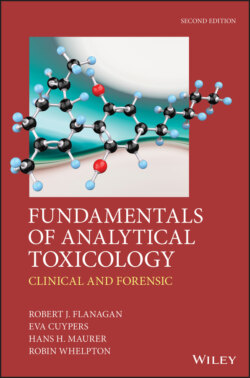Читать книгу Fundamentals of Analytical Toxicology - Robin Whelpton - Страница 79
2.5 Common interferences
ОглавлениеPlasticizers, particularly phthalates, may originate from plastic bags used to store transfusion blood, infusion tubing, and from soft plastic closures for blood tubes. Such compounds are often retained on reverse-phase LC systems (Section 10.5.3) and show good absorption at 254 nm and below. Polyvinylchloride (PVC), for example, can contain up to 40 % (w/w) di-2-ethylhexylphthalate and concentrations of this latter compound of up to ca. 0.5 g L–1 have been reported after storage of plasma in PVC bags for 14 days. Phospholipids are notorious for supressing ionization in LC-MS assays (Fabresse et al., 2017). A further consideration is that post-mortem specimens may contain putrefactive bases such as phenylethylamines and indole(s) that may interfere in the analysis of amfetamines and other stimulants. Hexanal may arise from breakdown of fatty acids. GC retention data and mass spectra of a number of plasticizers, pollutants, and other substances that may be encountered in toxicological analyses have been reported (Maurer et al., 2016).
Drugs may arise from unexpected sources including food and over-the-counter (OTC) medicines. Quinine may originate from ingestion of tonic water or malaria prophylaxis, for example, caffeine from caffeinated beverages (tea, coffee, cola) and some proprietary stimulants, chloroquine, and related compounds from malaria prophylaxis, and pholcodine and other opiate analogues from cough and cold cures. Morphine is a constituent of some antidiarrhoeal preparations and is present in poppy seeds. A caffeine metabolite, paraxanthine, may be a problem in some LC theophylline assays.
Lidocaine-containing gel is commonly used as a lubricant during procedures such as bladder catheterization or bronchoscopy, and measurable plasma concentrations of lidocaine and some metabolites may be attained. Lidocaine and propofol are commonly used in association with emergency procedures, but these compounds may be misused together. Ketamine and morphine may also be given as part of emergency procedures. The alkaloids emetine and cephaeline, and their metabolites, have been detected in stomach contents, plasma, and in urine after syrup of ipecacuanha (ipecac) was given to induce vomiting, especially in children, although this form of treatment is no longer recommended practice.
Sedatives such as pethidine (meperidine) may be given prior to computerized tomographic (CT) scans, lumbar puncture, or other investigations. Neuromuscular blocking agents such as atracurium, which is metabolized to laudanosine, and vecuronium, may be encountered in samples from patients undergoing mechanical ventilation. 1,3-Propanediol (propylene glycol) is used as a vehicle in some i.v. infusions. Benzoic acid, which is metabolized to hippuric acid, is used as a preservative in some drugs and foods.
The antibiotic metronidazole is often encountered in samples from hospitalized patients. Medical imaging media may interfere in a range of assays (Lippi et al., 2014). Alcohols may originate from skin cleansing swabs. Such compounds and also drugs given in emergencies, amiodarone, anticonvulsants such as diazepam, and propofol, for example, may not be recorded on record sheets. Some compounds or their metabolites may have very long plasma half-lives. Chlorpromazine metabolites, for example, have been reported in urine many months after stopping therapy. Primary amines and even morphine, for example, can be acetylated in gastric contents if aspirin has been co-ingested (Naso-Kaspar et al., 2013).
Contamination with trace elements is a particularly difficult area (Chapter 21). Contamination with volatiles, such as solvents used in the laboratory, must be guarded against if one of the solvents in question is to be tested for in a biological or related sample. Glassware and other items must be kept clean and tested regularly for contamination via IQC procedures.
